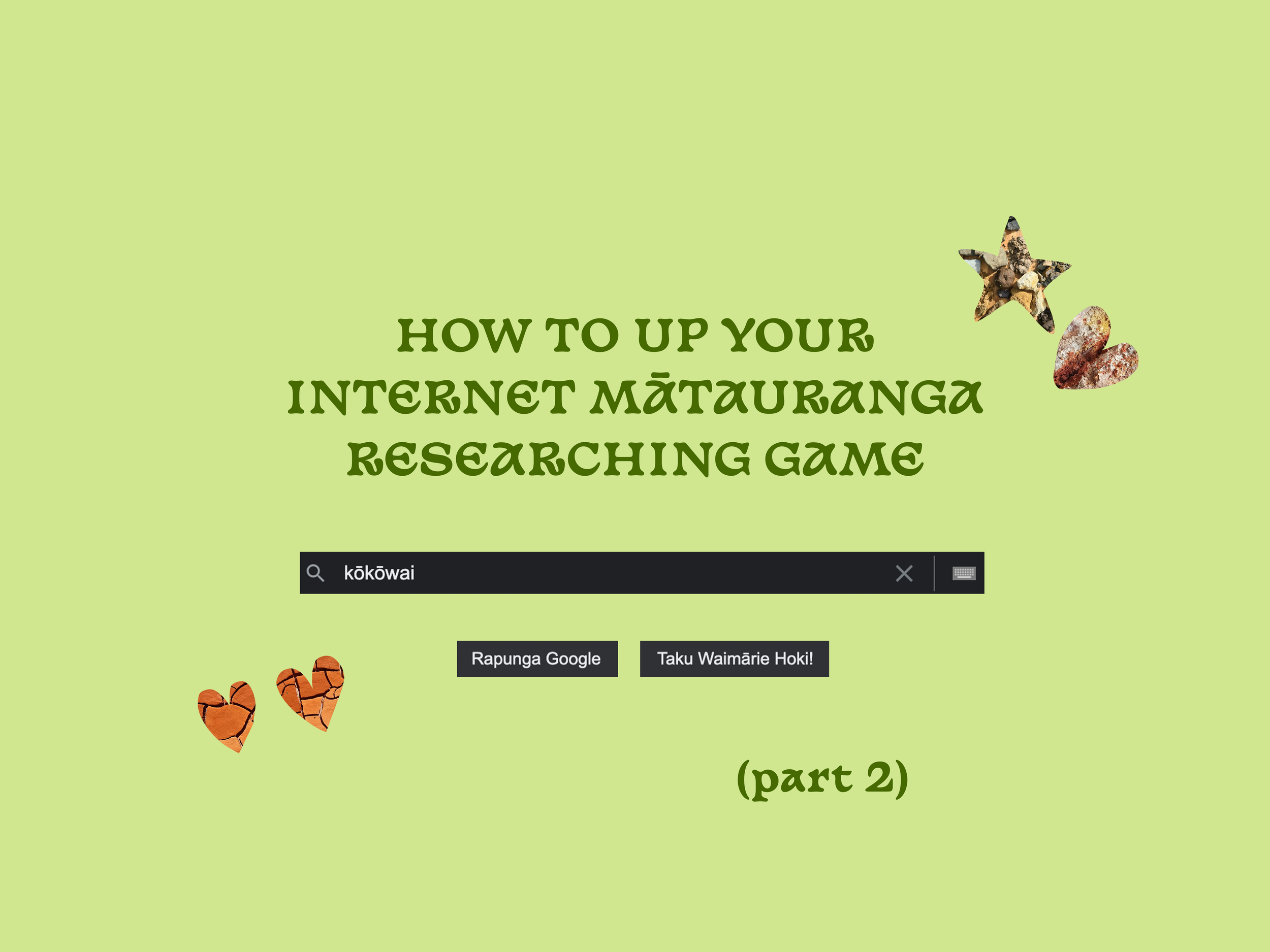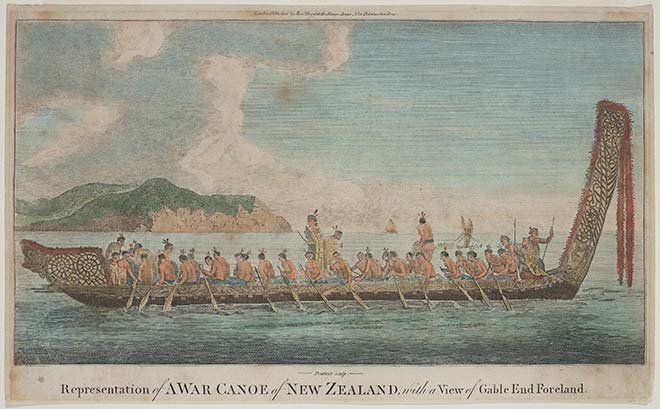
nā Kahu Kutia - March 22
In part 2, its time to put some of our sleuting skills to practice! Heres some places to start your search:
Find results from many different collections with one search! A really great place to do your first nosey.
While not all taonga are available to see online, there’s heaps of taonga that are viewable on the website. An amazing place to go for inspiration!
You can also search their online collections, and I’ve linked here to their blog site, which is full of articles, some about taonga Māori.
This is a portal to search through different collections held in the National Library. Everything from magazines and newspapers to books, manuscripts and images. Extra hot tip: have a look at the publication Te Ao Hou!
New Zealand Electronic Text Collection
Heaps of books and articles held in the Victoria University collection that you can read online! This resource is particularly good for accessing writing about our people from late 19th and early 20th century.
Ngā Taonga Sound & Vision
our audiovisual archive. Another rich source of content and inspiration. Though note, there’s heaps of stuff that isn’t available online without permission from the kaitiaki of those taonga.

Here’s some stuff I found by searching a few of these resources! My criteria were:
Material that talks specifically about the processing and use of whenua pigments
A focus on mātauranga Māori and local sources
Material that is easily and freely available on the internet.
Figure 6. AM31112.4 with multiple added tags; one-ply Z-twist, two-ply S-twist, cylindrical strips, kiekie thatch. Photograph by Tim Mackrell.
On the Māori Method of preparing and using Kokowai by Archdeacon Walsh
So I’ll start off by saying that this is one of those pieces with a massive colonial tone. Painting our taonga and practices as the products of a primitive soon to be lost race. If you can make it through that, here’s some interesting things this chapter talks about:
Use of black, white, and blue (pukepoto) pigments by our tīpuna, and they were made of, alongside a more in-depth analysis of kōkōwai (red pigment).
Interesting kōrero on processing kōkōwai/ gathering of oxide by burying fascines (bundles) of ferns in streams. Raw material gathered on the bundles and after the bundles were dried, a fine powder could simply be shaken off.
Some of the oils mixed with raw pigments, like shark oil, and oils processed from Titoki, Kohia, Miro, and Tangiao seeds.
References the use of kōkōwai as a woodpaint, cosmetic, and clothing dye, as well the use of kōkōwai in a traditional hahunga.
Some interesting kōrero about tapu associated with grinding stones, but it’s hard to unwrap from the colonial interpretation, and leaves some guessing to be done as to exactly how and when these tools might be tapu.
Records of the Auckland Museum Volume 52: Māori kākahu fragments from Piha: Whakaari Pā
Okay so this one is a bit more technical but is a cool little investigation in to some kākahu (textile) fragments that were found at Whakaari Pā at Piha. This one’s mostly based around weaving techniques, kupu, and history, BUT most of these fragments had been dyed in kōkōwai.
Most importantly, there are images of these pieces of kākahu where you can see beautiful brilliant rusted red patches where the kōkōwai has been dyed to the muka of the textile.
Tihei Mauri Ora: A Conversation in Paint
This tuhinga is an exegesis written by Rebekah Wardrop (Ngāti Whātua/Ngā Puhi) for the completion of a Master of Arts at AUT. Wardrop leads us through an exploration of mauri and Māori architecture in her work, with the main focus for this Kaupapa being a series of pou painted with kōkōwai.
Particularly relevant is the chapter with some brief notes on the history of kōkōwai, as well as kōrero about different kinds of pigment and colours that can be found today. There’s also some whakaaro and discussion about engaging with art practice with a Kaupapa Māori framework in mind.
The Painting of a Waka Taua
A chapter from The Maori Canoe by Elsdon Best. I think this one is useful for its description of different techniques that were used to paint a Waka Taua. Something new I learnt from this chapter was about the application of Poporo/Poroporo sap to the wood of a waka to prepare it for the application of kōkōwai paint. Similar to some other sources, it also talks about different kupu associated with pigment paints, differentiating Karamea and Takou from Kōkōwai and Horu. Though different sources aren’t always saying the same thing when they define how these words differentiate pigments.
There’s also a really cool piece of kōrero about how the taurapa and tauihu of a waka might be dyed black, with a hinau dye (as a mordant and supporter of the darkening process) and also some time soaked in a swamp. This kōrero referenced was first shared with Archdeacon Walsh by Hare Hongi.
An Investigation Into Locally Found Pigments in North Canterbury and Banks Peninsula and Their Historical, Experimental and Contemporary Use in Paint
Celia Wilson investigates earth pigments in North Cantebury and Banks Peninsula in this tuhinga in completion of a Bachelor of Fine Arts (Honours). The writing draws on historical Mātauranga Māori at points though it seems that Wilson is not Māori, and the writing lacks any acknowledgement of tangata whenua as kaitiaki of these whenua.
In particular, Wilson gets quite technical in her explorations, and writes quite a lot about different processes and ingredients for her paint experimentations. Not all the components are indigenous or traditional, and maybe could be more inspiration for those of you wanting to really experiment in your journey with whenua.
Image depicting a Waka Taua, from Te Ara
Close up on work by Raukura Turei
Te Wheiao II by Nikau Hindin
Painting with Whenua: An Interview with Raukura Turei
A beautiful piece to read! Less academic, a conversation between two wāhine Māori (both talented architects) where Jade Kake talks to Raukura Turei about her practice as an artist working with uku paint.
Here’s a really lovely paragraph from the piece:
“The blue colour of the aumoana clay paint evokes that interstitial time, just before dawn. This time that has always had significance for us as Māori. Moving between the layers on the canvas evoke the wiriwiri, the flickering, moving between spaces, states. It’s easy to get lost in the canvas, in a sea of thoughts and associations. I think about those long karakia that occur just before the dawn, before the sky breaks, I think about my own whenua and its silty clay soils, the shimmering blue of the harbour at dusk. As I gaze at the canvas, I think about my tūpuna whaea, the women from whom I descend.”
Artist talk with Nikau Hindin
Talented wahine Māori artist Nikau Hindin shares kōrero about her exhibition Kōkōrangi ki Kōkōwai at The Dowse in June 2020. Most of this talk relates to the practice of beating aute, and Hindin’s personal history with this rākau. Including some cool information about navigation and Māori astronomy. That will also be of interest to many of you!
Nikau Hindin also uses whenua pigments extensively in her mahi. About 24 minutes in to this kōrero, she talks a little about her specific pigment processing techniques, including some of what she learned from our whanaunga in Hawai’i.



